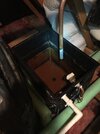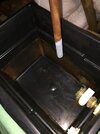- Joined
- 8 May 2017
- Messages
- 10,479
- Reaction score
- 2,775
- Country

Manual lever is used when draining or filling a system ,so on a 3 port valve it is latched open to mid position ,both ports ( hot water cylinder and central heating).
When system is filled ,manually unlatch the valve.
In certain circumstances,for instance if you can't get boiler to work for heating ,but it works for domestic hot water, latching the valve would give you some Central heating ,when boiler is set for domestic hot water. Unfortunately once the hot water in the cylinder is up to temperature the boiler would cut off.
When system is filled ,manually unlatch the valve.
In certain circumstances,for instance if you can't get boiler to work for heating ,but it works for domestic hot water, latching the valve would give you some Central heating ,when boiler is set for domestic hot water. Unfortunately once the hot water in the cylinder is up to temperature the boiler would cut off.


